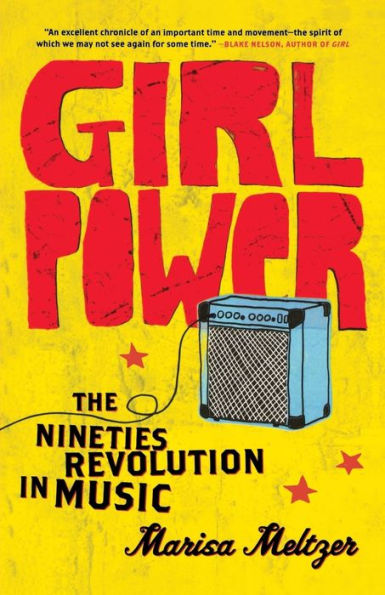

Paperback(First Edition)
-
PICK UP IN STORECheck Availability at Nearby Stores
Available within 2 business hours
Related collections and offers
Overview
The movement's message of "revolution girl-style now" soon filtered into the mainstream as "girl power," popularized by the Spice Girls and transformed into merchandising gold as shrunken T-shirts, lip glosses, and posable dolls. Though many criticized girl power as at best frivolous and at worst soulless and hypersexualized, Marisa Meltzer argues that it paved the way for today's generation of confident girls who are playing instruments and joining bands in record numbers.
Girl Power examines the role of women in rock since the riot grrrl revolution, weaving Meltzer's personal anecdotes with interviews with key players such as Tobi Vail from Bikini Kill and Amy Ray of the Indigo Girls. Chronicling the legacy of artists such as Bratmobile, Sleater-Kinney, Alanis Morissette, Britney Spears, and, yes, the Spice Girls, Girl Power points the way for the future of women in rock.

Product Details
| ISBN-13: | 9780865479791 |
|---|---|
| Publisher: | Farrar, Straus and Giroux |
| Publication date: | 02/02/2010 |
| Edition description: | First Edition |
| Pages: | 176 |
| Sales rank: | 1,152,612 |
| Product dimensions: | 5.40(w) x 8.20(h) x 0.53(d) |
About the Author
Read an Excerpt
RIOT GRRRLS
The Evergreen State College in Olympia, Washington, is the kind of university that offers neither grades nor majors. Its central quad is called Red Square; its concrete-block, riot-proof buildings are nestled among acres of forested land; and the chili in the main café is always vegan. As can be expected from its left -of-center reputation, the school has attracted a mix of outcast students since its inception in 1967: hippies, slackers, and punks. It’s also my alma mater. And I count myself as one of them.
Olympia is the capital of Washington State. It’s small—the population only about forty thousand—and some of the only decent jobs available to graduates who want to stick around are for the state government. But it was (and still is) cheap enough that a bohemian existence can be fairly easily cobbled together with part-time day jobs conducive to the lifestyle of a fledgling band. In the mid-eighties, an all-ages punk scene cropped up in the city, buoyed by a club called the Fabulous Tropicana; the student radio station KAOS; the music fanzine Op; and Calvin Johnson’s label, K Records, and his band, Beat Happening.
To a certain kind of person, the Olympia lifestyle could seem ideal. The musician Tae Won Yu moved there from his native New York City in the spring of 1992 because it felt like “a paradise. I woke up every morning feeling like, ‘I can’t believe I’m in Olympia. It’s like Paris in the thirties.’” The singer Mirah Zeitlyn describes early nineties life in Olympia: “We were all making rock operas and we had this huge theater we could use when we wanted. There are certain kinds of energy that maybe can’t be replicated.” Naturally, she or ganized her college music collection not alphabetically or by genre, but by gender. “I didn’t think twice about it. Sometimes I want to listen to this stuff that men make and sometimes I want to listen to this stuff that women make.”
The Olympia musician Lois Maffeo grew up in the cultural doldrums of Phoenix, Arizona, and heard about Evergreen through a high school friend who was being hassled by her hippie uncle to go there. “I was like, ‘No grades? I’m so sold,’” she recalls. Maffeo had a by-the-books college paradigm shift: her first dorm mate was a punk girl with dyed blond hair and raccoon-like makeup. Calvin Johnson of Beat Happening helped Maffeo learn the guitar by drawing her a three-chord chart and saying, “People have done worse with more.” She went to art shows at a space called Girl City and hosted a radio show of music entirely made by women called Your Dream Girl on KAOS. “I locked into the fact that girls just run this town,” said Maffeo. “Going to an all-girl high school, there wasn’t that constant trying to vie for the attention of boys. I felt like girls were rad. I didn’t need to be convinced.” The writer Mikki Halpin lived in Los Angeles but knew the town by reputation: “There were a lot of people who really would make a very convincing claim at that point in time that Olympia was a matriarchy.”
On the other side of the country, Washington, D.C., was a city known for its punk bands. It was also where Calvin Johnson had lived during high school. He had befriended many of the bands in D.C., and in the years after he moved back to his native Olympia to attend college, a kind of cultural exchange developed between the underground music scenes in the two cities.
In 1991, Maffeo was living in D.C.’s Mount Pleasant neighborhood when riots broke out following the shooting of a Salvadoran man by a black female police officer who had been trying to arrest him for disorderly conduct during a Cinco de Mayo celebration. “They went on for days. You’d run home from the bus stop hoping not to get hit by anything,” says Maffeo. Watching the physical confrontation between a community and the police was oddly energizing, she remembers. “We realized you can push back, it’s okay. It really was an exciting feeling.” One day during the riots, her housemate Jen Smith ran into the house and said, “What we need is a girl riot.”
Excerpted from GIRL POWER by Marisa Meltzer.
Copyright © 2010 by Marisa Meltzer.
Published in 2010 by Farrar, Straus and Giroux.
All rights reserved. This work is protected under copyright laws and reproduction is strictly prohibited. Permission to reproduce the material in any manner or medium must be secured from the Publisher.
